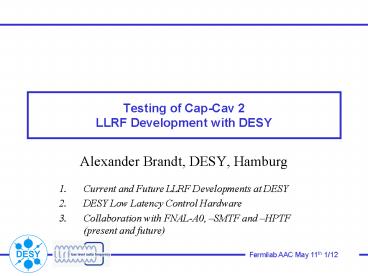Testing of CapCav 2 LLRF Development with DESY - PowerPoint PPT Presentation
1 / 13
Title:
Testing of CapCav 2 LLRF Development with DESY
Description:
Alexander Brandt, DESY, Hamburg ... Very high degree of automation needed (e.g. global phase control, recovery automation) ... VM. ADC ... (32) DSP. DAC ... – PowerPoint PPT presentation
Number of Views:31
Avg rating:3.0/5.0
Title: Testing of CapCav 2 LLRF Development with DESY
1
Testing of Cap-Cav 2LLRF Development with DESY
- Alexander Brandt, DESY, Hamburg
- Current and Future LLRF Developments at DESY
- DESY Low Latency Control Hardware
- Collaboration with FNAL-A0, SMTF and HPTF
(present and future)
2
DESY LLRF Contributors
- DESY, Hamburg, Valeri Ayvazyan, Alexander Brandt,
Gerhard Grygiel, Thomas Fröhlich, Olaf Hensler,
Matthias Hoffmann, Bastian Lorbeer, Frank Ludwig,
Günther Möller, Kay Rehlich, Stefan Simrock,
Henning Weddig, ... - WUT-ISE, Warsaw, Tomasz Czarski, Krzystof Czuba,
Tomasz Filipek, Wojciech Giergusiewicz, Wojciech
Jalmuzna, Pawel Kaleta, Waldemar Koprek, Karol
Perkuszewski, Piotr Pucyk, Ryszard Romaniuk,
Jaroslaw Szewinski, ... - TUL-DMCS, Lodz, Wojciech Cichalewski, Piotr
Cieciura, Mariusz Grecki, Tomasz Jezynski,
Boguslaw Koseda, Dariusz Markowski, Pawel Pawlik,
Przemsylaw Sekalski, Bartlomiej Swiercz, Marcin
Wojtowski, ... - IHEP, Protvino, Nikolay Ignashin, Sergej Sytov,
... - INFN, Milano, Angelo Bosotti, Rocco Paparella
- KEK, Japan, Shin Michizono, Toshi Matsumoto
- Yerewan Institute, Gevorg Petrosyan, Ludwig
Petrosyan - ...
3
LLRF Developments at DESY VUV-FEL
- Running since 2004 (as successor of TTF1,
1997-2003) - SC linear injector, 6 undulator sections (down to
6nm wavelength) - Pulsed operation (2ms / 1-10Hz)
- 1 nc cathode, 48 sc cavities, 1 transverse
deflecting cavity - 5 rf stations (one klystron per 8-32 sc cavities)
- Field stability requirement 10-3 / 0.1
- Designed as user facility and for accelerator
development - Ideal testbed for LLRF developments!
VUV-FEL
4
LLRF Developments at DESY VUV-FEL
5
LLRF Developments at DESY XFEL, ILC
- FEL lightsource for sub-nm wavelength,
commissioning 2012 at DESY - 1000 cavities, 35 klystrons
- High field stability 10-4, 0.01
- User facility (high reliability)
- Demands for a low-maintenance, radiation
resistive hardware
XFEL
ILC
- Future project, not yet scheduled (2012-2020?)
- 20000 cavities
- Collider experiment, therefore relaxed field
requirements - Very high degree of automation needed (e.g.
global phase control, recovery automation)
6
Vecor Sum Control Challenges
VM
... (32)
1.3
ADC
DSP
DAC
- Latency in control loop limits feedback gain (and
therefore field stability) - ? build faster feedback hardware (Current
revision SimCon 3.1 FPGA system, 200ns) - Mechanical / electrical detuning limits
performance and increases power demand - ? build fast resonance frequency control system
(piezo or magnetostrictive tuning) - Calibration of signals determines precision
(nonlinear effects) - ? build transient detection hardware
- Reference and Distribution determines field
stability - ? build long range temperature stable reference
system
7
Further Projects
8-channel downconverter boards (already in
operation)
Bubble Neutron Dosimetry system w/ automatic
readout s/w
Piezoelectric tuner installed at one cavity
Transient detection hardware (test setup)
Box equipped with several field detectors for the
rf gun
8
DESY's Low Latency Control Boards
- SimCon 2.1
- 2004
- 2xADCs, 2xDACs
- Virtex II FPGA
- Successfully tested at DESY 9-cell teststand
(single cavity) - Successfully tested at A0
- Optical Gigalink 2.0GB/s mezzanine card
- Measured latency 200ns160ns!
- SimCon 3.0
- 2004
- 8xADCs, 4xDACs
- Virtex II FPGA
- Successfully tested at DESY 9-cell teststand
- Vectorsum Test at VUV-FEL scheduled for May/June
- Optical Gigalink on board (3.125GB/s)
- Measured latency 200ns160ns!
- SimCon 3.1
- 10xADCs, 4xDACs
- Virtex II Pro FPGA with 2 PPC405
- 2x Optical Gigalink
- Schematics finished
- Prototypes expected in July
- SimCon x.x
- 128xADCs, 64xDACs
- Allows complex control algorithm
- Account for additional signals
- DSP C-67
- Successor of C-40
- (1997-2003)
- TI C-67 CPU
- In Operation for VS control since 2004
- 8 Gigalink channels
- No ADCs/DACs on board
- 3us
C-67 DSP Board
SimCon3.1 Block Diagram
SimCon3.0 Board
SimCon2.1 Board
9
LLRF Plans for A0/SMTF (Present / Short Term)
- Refer to Brian Chase talk
- What we have done already
- Commision SimCon 2.1 prototype (1 week in March
05) at A0 - Achieved high gain (100) already
- Cleaned up DOOCS control system at A0
- What we plan (short term, May '05 until end '05)
- Again set up SimCon 2.1 at A0
- Improve calibration of system
- Test various algorithms
- Establish remote connection DESY ?? FNAL
- Update DOOCS control system at FNAL
- DESY support by G. Grygiel, O. Hensler, K.
Rehlich - DOOCS has interface to other systems, e.g. EPICS
10
Tests in March '05
Readout Panel Top I and Q (blue) resp.
Amplitude and Phase (red) of the Cavity Bottom I
and Q setpoint curves
Matlab Control Panel Feedback Gain in the order
of 100
11
LLRF Plans for A0/SMTF (Medium / Long Term)
- Refer to Brian Chase talk
- What we plan (medium term, starting from end '05)
- Continue support on the DOOCS control system at
FNAL - Provide further SimCon systems (SimCon 3.1 to
arrive by the end of this year) - Provide signal detection hardware
(downconverters) - Collaboration with FNAL-staff on algorithm
development - What we plan (long term)
- Provide and support further SimCon systems
- Continue support on the DOOCS control system at
FNAL
12
Summary and Outlook
- Based on the successful experience of TTF1 (first
machine with VS control) and VUV-FEL, DESY is
currently in the process of developing the LLRF
control for XFEL - Development of LLRF control for XFEL already
accounts for the requirements of ILC (automation,
radiation hardness) - Demonstrated single cavity control at A0 in March
'05 - Established collaboration with FNAL for FPGA
software development - Plan to equip SMTF with next revisions of SimCon
- As a universal digital control system SimCon is
applicable to many accelerators (in principle it
is not restricted to LLRF control only)
13
(No Transcript)































